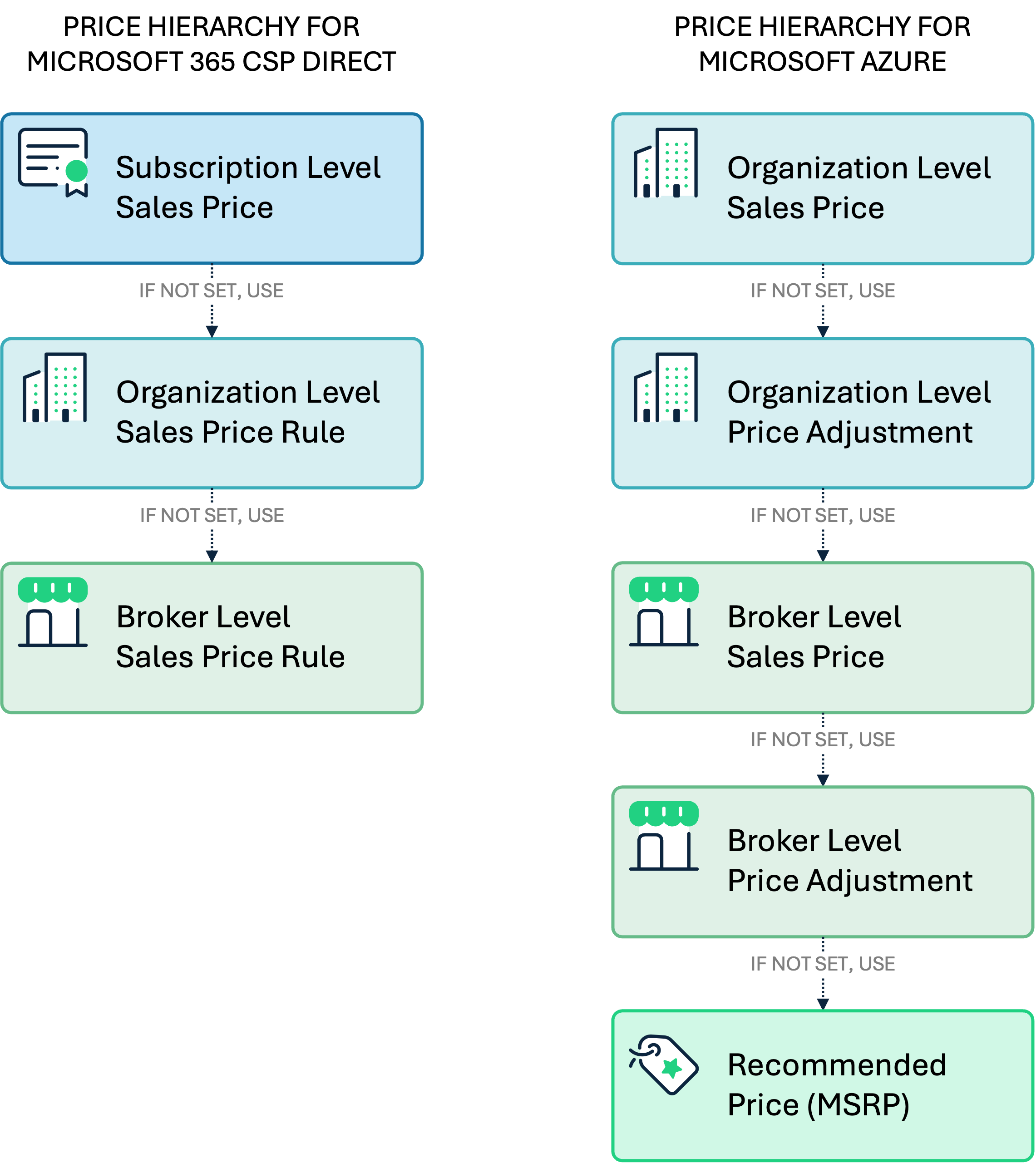Price Management
Overview
This document covers the main features of Price Management, the most common price management use cases, the different levels on price management and the price hierarchy of how subscription commitment price is taken.
Most Common Price Management Use Cases
Maintain a Fixed Margin Percentage
Case: You want to set a margin percentage that will not change, regardless of any vendor level pricing changes.
Solution: Set a Fixed Margin Price Rule in the Price List. This will keep a consistent margin percentage in subscription pricing and billing. For example, you set a 5% fixed margin, which will maintain that percentage even when Microsoft changes their cost prices.
Maintain a Fixed Discount Percentage
Case: You want to set a percentage discount on recommended price, that will maintain that percentage discount, even if vendor level MSRP changes.
Solution: Set a Discount on MSRP Price Rule in the Price List. This will keep a consistent discount percentage on Recommended price in subscription pricing and billing. For example, you set a 7% discount on MSRP, which will maintain that percentage even when Microsoft changes their list prices.
Retrospective Pricing Correction
Case: You or your customer identifies a pricing error or renegotiation that requires retroactive adjustment.
Solution: When the subscription period has already passed, the best way to adjust historic billing is by adding manual billing lines.
The manual billing lines are meant for one-time adjustments in the billing. These will produce separate billing lines to keep track of the adjustment.
Mid-Term Price Change (In-Contract)
Case: Customer renegotiates during contract term; pricing changes need to apply from a specific date forward.
Solution: The best way to adjust the price of an ongoing subscription is by using the Subscription Price Correction functionality.
By setting a custom subscription level price, it adjusts the price only for the current period. The price for the next period, after the renewal, would be taken from Price List, as normal.
Pricing Changes at Subscription Renewal
Case: Pricing needs to be updated at renewal, often with agreed changes or margin adjustments.
Solution: If the price needs to change after renewal, then it would follow the normal trajectory of picking the right price from the Price List.
If an Organization level price is set in the Price List, that price would be chosen. If not, the global, Broker level price would be used and applied automatically, on subscription renewal.
Price Hierarchy
The illustration below describes the hierarchy of how pricing is applied for Microsoft 365 CSP Direct and Microsoft Azure services.

The priority of Price Rules on the same level are determined by their Start Dates and End Dates.
When the Start Date of a Price Rule is reached, it becomes Active and will be used for new subscriptions only. When a Price Rule becomes active, it will not change the prices of existing subscriptions.
When where are several active price rules simultaneously, the one with a newer Start Date will take priority, as it’s assumed it’s a more accurate one, or a temporary one.
Subscription Price Commitment
The price that is quoted at the creation of a subscription will be committed until the end of the subscription period.
Changing the price in the price list (Broker or Organization level) does not change the subscription’s price during that commitment term.
The subscription price will only change on renewal, when the subscription is committed to another commitment term. For that new commitment term, the subscription price is locked again.

This logic applies for Microsoft 365 CSP Direct and for Custom Service subscriptions.
Price List
The Price List consists of the Broker Level (Global) Price List and the Organization Level Price List.
The Broker Level Price List sets default prices that apply to all customers, helping maintain consistency across the board.
The Organization Level Price List allows brokers to set custom prices for individual customers, overriding the Broker Level prices when needed. If no changes are made at the organization level, the Broker Level price will still apply.
This setup gives brokers flexibility while keeping pricing structured and easy to manage.
Price Adjustment/Azure Price Management
Azure Price Adjustment in Cloudmore allows brokers to modify the pricing of Microsoft Azure services by applying a mark-up or markdown percentage to the base cost. This helps brokers align pricing with customer agreements and ensure profitability across different Azure pricing models.
Subscription Level Price Correction
Subscription Level Price Correction lets brokers adjust the price for a specific subscription when general pricing rules (like broker-level or organization-level) don’t fit. It’s useful for handling special cases where a custom price is needed just for one subscription.
Pricing Flow for Custom Services
In a custom services pricing model involving a Seller, a Broker, and an Organization, the pricing flows through each layer in a structured way: the Seller’s sales price becomes the Broker’s cost, meaning the Broker pays the Seller that amount to acquire the service.
The Broker then sets their own sales price, which becomes the Organization’s cost when purchasing the service. Throughout this chain, the Suggested Price is inherited directly from the Seller, serving as a reference point to guide pricing decisions and maintain consistency across all levels.
